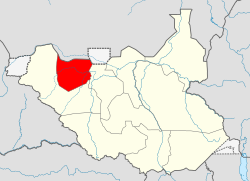Northern Bahr el Ghazal
Northern Bahr el Ghazal
شمال بحر الغزال Šamāl Baḥr al-Ğazāl | |
|---|---|
 Outdoor classroom in North Bahr al Ghazal, 2002 | |
 Location in South Sudan. | |
| Country | |
| Region | Bahr el Ghazal |
| Capital | Aweil |
| Area | |
| • Total | 30,543 km2 (11,793 sq mi) |
| Population (2008) | |
| • Total | 720,898 |
| • Density | 23.6/km2 (61/sq mi) |
| Time zone | UTC+3 (EAT) |
Northern Bahr el Ghazal (Arabic: شمال بحر الغزال; transliterated: Šamāl Baḥr al-Ğazāl) is one of the 10 states of South Sudan. It has an area of 30,543 km²[1] and is part of the Bahr el Ghazal region. It borders South Darfur to the north, Western Bahr el Ghazal to the west and south, and Warab and Abyei to the east. Aweil is the capital of the state.
Because of its proximity to Kordofan and the presence of a railway line through it to Wau it suffered extensively in the recently ended civil war in southern Sudan. North Bahr al Ghazal and adjacent parts of Western Kordofan to the north are among the most politically sensitive regions in Sudan. Missriya Arabs from Kordofan have interacted with Dinka in this region over a long time. While relations during the colonial era were largely peaceful, the recent war saw an upsurge in hostilities. Government backing to the Missriya gave them a decided advantage over local Dinka groups, and raiding by murahileen militias (and other government backed groups, including some Dinka militias) resulted in considerable loss of life, widespread abduction and pillaging of Dinka villages. Many of these raids coincided with the movement of government trains to and from Kordofan to Wau.
Government
Paul Malong Awan is the governor of the state. He swore in new state cabinet on July 22, 2008. Its members are:
- Deputy Governor & minister of information & communication - Arkenjelo Athian Teng Angok
- State Minister of Finance - Ajou Garang Deng (Ajou Makot)
- State Minister of Health - Ms. Akon Bol Akok
- State Mister of Parliamentary Affairs - Garang Diing Akuong
- State Minister of Education, Science and Technology - Stephen Chol Unguec
- State minister of Local Government and Law Enforcement Agents - Bak Lual Bol (Bak Abu-ajac)
- State minister of physical infrastructure - Giir Riiny Lual
- State minister of Agriculture - Angui Akot
- Secretary General of State Council of Ministers - Yel Deng Nguel
State Advisors are:
- Pio Tem Kuac Ngor - Political Advisor
- Tong Atak Mel - Economics Affairs Advisor
- Akok Bol Mador - Local Government
- Riak Wol Atuer - Security Advisor
Administrative divisions
Northern Bahr al Ghazal, like other states in South Sudan, is divided into counties, headed by a County Commissioner, as illustrated below:[2]
- Aweil North County - Estimated Population (2008) - 129,130 - Angui Diing Diing
- Aweil East County - Estimated Population (2008) - 309,920 - Diing Aher Ngong
- Aweil West County - Estimated Population (2008) - 166,220 - Santo Ayuel Akuei
- Aweil Central County - Estimated Population (2008) - 41,830 - Deng Dhieu Nyiwel
- Aweil South County - Estimated Population (2008) - 73,810 - TBA
References
- ^ "Northern Bahr El Ghazal". South Sudan Disarmament, Demobilisation and Reintegration Commission.
- ^ 2008 South Sudan Population Ma By County
Books
- Francis M. Deng, 1995, War of Visions, Conflict of Identities in the Sudan, (Washington D.C.: Brookings)
- Human Rights Watch, 1999, Famine in Sudan, 1998, The Human Rights Causes, (New York, Human Rights Watch).
- Dave Eggers, 2006, What is the What, (New York, Vintage Books).
- David Keen, 1994, The Benefits of Famine, A Political Economy of Famine and Relief in Southwestern Sudan, 1983–1989, (New Jersey, Princeton University Press).
External links
- John Ryle, Jok Madut Jok and Fergus Boyle, 2003, Sudan Abduction and Slavery Project, Abductee Database 2003 Report
- "Northern Bahr el Ghazal State gets in new cabinet" [1]
